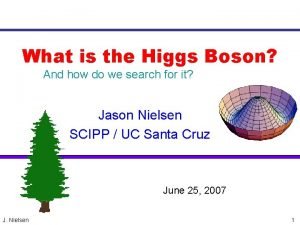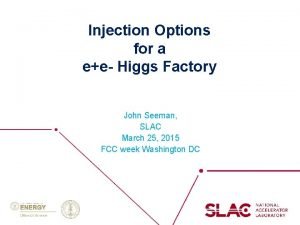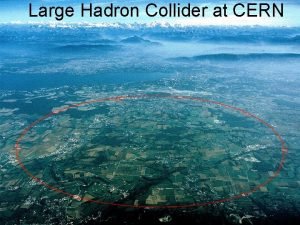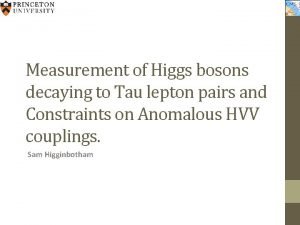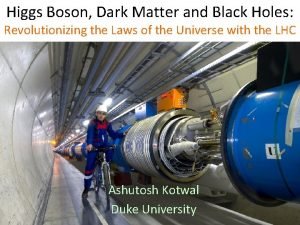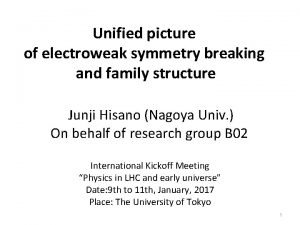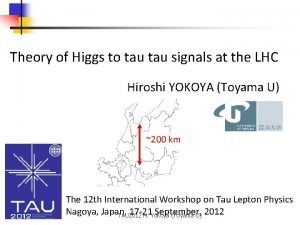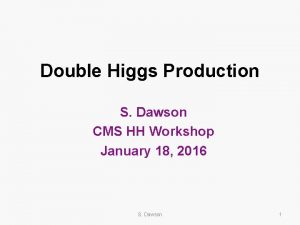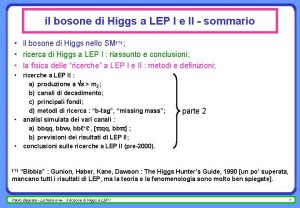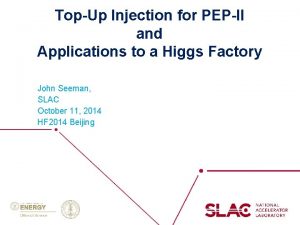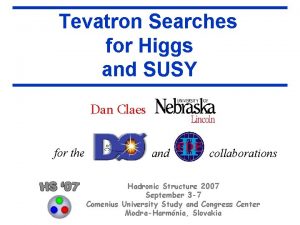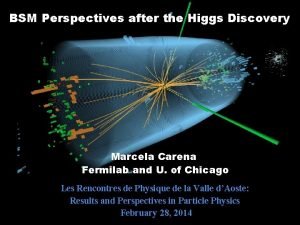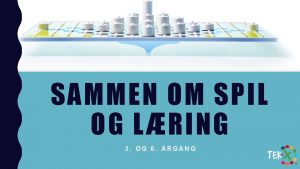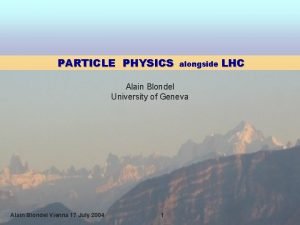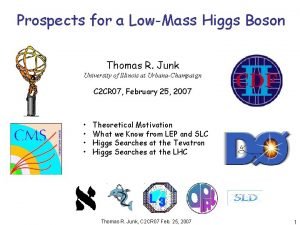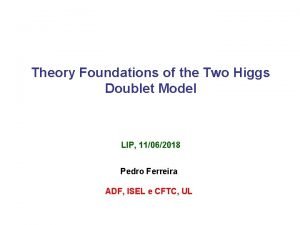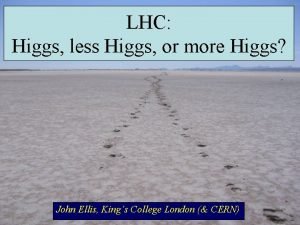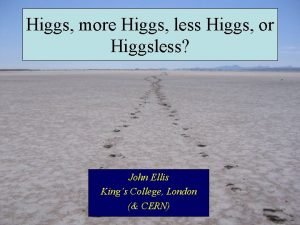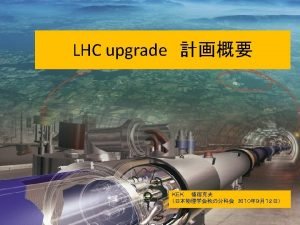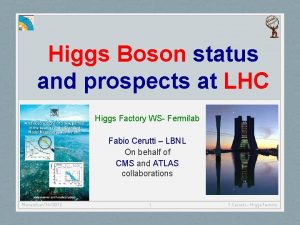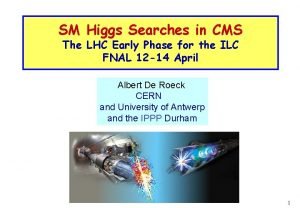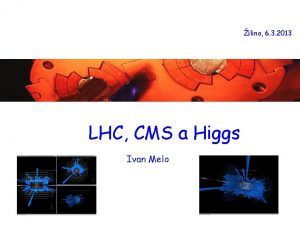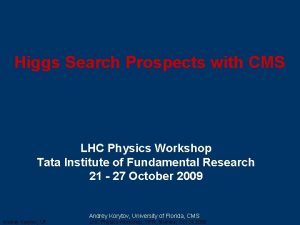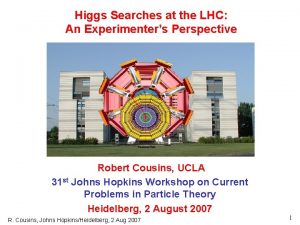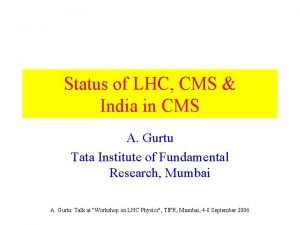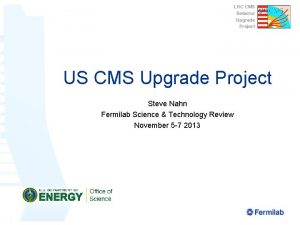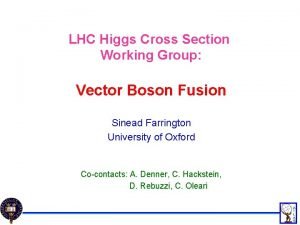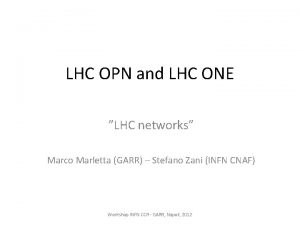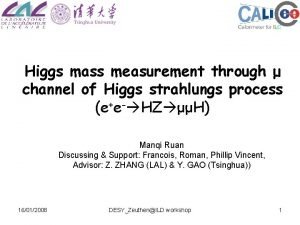CMS perspective on the LHC Higgs XS working



















- Slides: 19

CMS perspective on the LHC Higgs XS working group recommendations for the Higgs couplings investigation Marco Zanetti (MIT) 1

Introduction • Low Mass Higgs WG activities and discussion advertized within CMS – Regular reports in the Higgs Combination group • Prototypes of models similar to the one proposed in the document implemented and tested – Public results on ICHEP dataset and about projections (ESG) • CMS already familiar with these models 2

CMS response to the document • The document has been presented and described in details to the collaboration (via the Higgs group) • The content of the document gathered general consensus: – Need of probing in a consistent manner the coupling structure of the Higgs candidate. Experiments and theoreticians need to have a common ground to compare results – Run 2012 integrated lumi allows addressing only a limited number of free parameters. Models proposed in the document seem reasonable – There is confidence in theoretical basis of the models 3

CMS response to the document • Overall what proposed is perceived as a good starting point to address the coupling structure • Possible developments (e. g. theoretically driven) on the benchmark models are encouraged • Additional models can always be considered • Comments miscellanea: – Are these fit models biased? – What is the projected precision achievable by the benchmark models (to possibly keep aside the ones with limited sensitivity) – How do the benchmark models behave against non SM signals? – The inclusion of these models in the overall SM fits could be considered (e. g. when fitting for undetectable/invisible particles) – … 4

BACKUP 5

The document • Document available at: https: //twiki. cern. ch/twiki/pub/LHCPhysics/Higgs. Light. Mass/LHCHXSWG-2012 -001. pdf • Edited by theorists and experimentalists • Content discussed in the LM LHC HXS meetings https: //twiki. cern. ch/twiki/bin/view/LHCPhysics/Higgs. Light. Mass#Meetings 6

Scope • The “Low Higgs mass” subgroup of the LHC HXS WG in charge of providing recommendations related to the Higgs properties measurement • This document addresses the characterization of the coupling structure – JCP not discussed • We fit for the SM Higgs, seeking for deviations, possibly to exclude the SM Higgs – Other scenarios are not assessed – Model dependent fits • Goal is to define benchmark parameterizations to be used to fit the data – Common ground (same notation, apple-to-apple comparison) for experiments and theoreticians 7

Assumptions • No specific assumptions on new physics • Just one single narrow resonance • Higgs Width GH is negligible, zero-width approximation is used: • Only modifications of the coupling strengths are allowed, the SM tensor structure is assumed – The signal is a CP even scalar 8

Coupling scale factors • A set of k to scale the SM production cross sections and decay widths – SM predictions as from the LHC XS Yellow Reports (arxiv: 1101. 0593) • Partial widths not detectable at LHC via proxies to detectable ones • Scaling for couplings through loops defined either – As function of scale factors for the fields in the loop – As additional free parameter • Total width can be either take as the sum of the partial widths or as additional degree of freedom – In the latter case one of the original free parameter gets redefined as: • k. X -> k. X/k. H 9

Coupling scale factors Production modes Detectable decay modes Undetectable decay modes 10

scale factors for loops • In the case of coupling via loops scale factors are functions of the other scale factors • Example: the gluon fusion cross section scaling: • Where sgg. Htt, bb is the square of the top and bottom contributions and sgg. Htb is the square of the interference terms – Interference term is negative for MH<200 Ge. V • Similar expressions implemented for other loops (gg, Zg) – VBF is also expressed as combination of k. W and k. Z • Alternatively the dependency on other scale factors can be discarded and treat the loop scale factor as additional free parameter 11

Further assumptions • NB: the document addresses the integrated luminosity envisaged for 2012 run => estimations are statistically limited • Theoretical uncertainty: – Th. Uncertainties will directly affect the scale factors determination • Zero width approximation – 1% effect in the low mass range • Signal interference effects – H->ZZ->4 f analyses correctly rely on BR(H->4 f), at 125 Ge. V 10% effect w. r. t BR(H->ZZ)x. BR(Z->2 f) – H->ZZ and H->WW data are however scaled with k. Z and k. W • Treatment of light fermions – G for electrons, up and down quarks are neglected – Proxies used for the undetectable ones – Light flavors also neglected in the loops 12

BENCHMARK MODELS 13

1 common scale factor • Same as usual m parameters, but for the square (consistency in the uncertainties w. r. t the other models) • High experimental precision, but little informative on the role of the Higgs candidate. . 14

Bosons and Fermions (a. k. a c. Vc. F) • • Straightforward extension to 2 parameters fit Fermion universality and custodial SU(2) are assumed Loop structure as predicted by SM (As for the other models) to be implemented with no assumption on the total width too 15

Custodial symmetry • Main parameter is l. WZ=k. W/k. Z • SM predicts small violation of custodial SU(2), Dr>1 16

Fermion sector (1) • Group the fermions in up and down type, main parameter is ldu=kd/ku 17

Fermion sector (2) • lll • Group the fermions in leptons and quarks, main parameter is llq=kl/kq 18

Invisible/undetectable decays • Look for violation in the loop couplings using the relative scale factors (kg and kg) as parameters for the fit • Undetectable/invisible decay are constrained by additional parameter in the total width (BRinv, undet) 19
 Higgs boson
Higgs boson Higgs factory
Higgs factory Higgs
Higgs Higgs
Higgs Higgs boson black hole
Higgs boson black hole Higgs singlet
Higgs singlet Higgs to tau tau
Higgs to tau tau Higgs singlet
Higgs singlet Bosone di higgs
Bosone di higgs Chelsea higgs wise
Chelsea higgs wise Higgs factory
Higgs factory Higgs
Higgs Marcela carena
Marcela carena Hungry higgs brætspil
Hungry higgs brætspil Higgs factory
Higgs factory Higgs boson
Higgs boson Two higgs doublet model
Two higgs doublet model Hot working and cold working difference
Hot working and cold working difference Machining operations
Machining operations Hard work vs smart work presentation
Hard work vs smart work presentation
